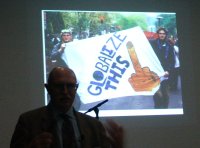




Garnet Hertz is working on a doctoral dissertation in Media Theory & History based on the “The Dead Media Handbook” as initially proposed by Bruce Sterling in 1995 in his “Dead Media Manifesto” (http://www.deadmedia.org/modest-proposal.html).
His plan is to actually publish a book, taking into account, and using the work, notes and collections assembled on Deadmedia.org
Hertz’ curatorial vision on the project is to “dissect the topic of “new” media from an engaged historical, theoretical and technical perspective. At its basis, this project assumes that changes/revolutions in communications technologies are a liquid but consistent cycle. Although inconsistencies and true revolutions do occur, this project will not focus on these: instead, common threads and trends will be explored. “The Dead Media Handbook” is a field guide in the world of hype.”
“As a response to the hype of the internet, CD-ROMs and VR systems of the day, Sterling saw that an archaeological media-analysis was required of earlier mediaforms to gain a wider perspective on “new” media. “Plenty of wild wired promises are already being made for all the infant media. What we need is a somber, thoughtful, thorough, hype-free, even lugubrious book that honors the dead and resuscitates the spiritual ancestors of today’s mediated frenzy. A book to give its readership a deeper, paleontological perspective right in the dizzy midst of the digital revolution. We need a book about the failures of media, the collapses of media, the supercessions of media, the strangulations of media, a book detailing all the freakish and hideous media mistakes that we should know enough now not to repeat, a book about media that have died on the barbed wire of technological advance, media that didn’t make it, martyred media, dead media. THE HANDBOOK OF DEAD MEDIA.”
Read about Hertz: http://www.conceptlab.com
and his PHD proposal: http://www.conceptlab.com/uci/phd/
















